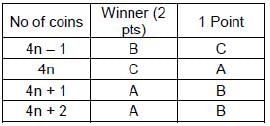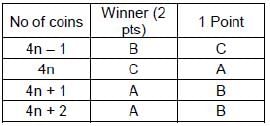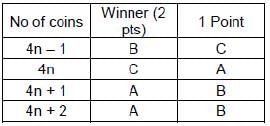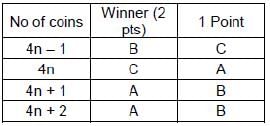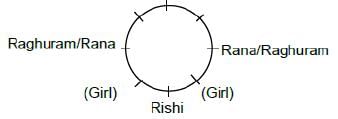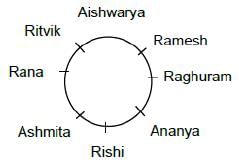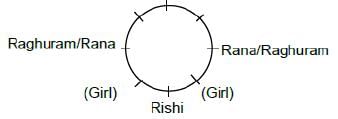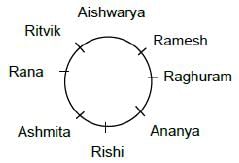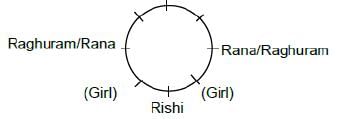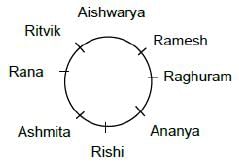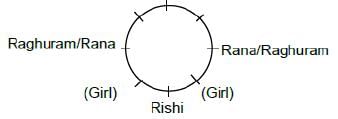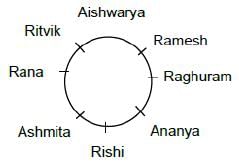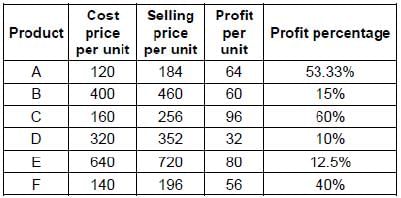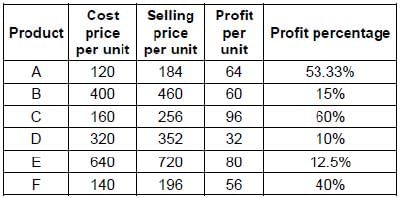CAT DI And LR Mock Test - 3 - CAT MCQ
25 Questions MCQ Test - CAT DI And LR Mock Test - 3
DIRECTIONS for questions: Answer the questions on the basis of the information given below.
Sudheer is interested in electronic gadgets and he made a new metallic keyboard for his computer. However, while marking the keys with letters, he made a mistake in marking the vowels such that none of the vowels were marked correctly with their corresponding keys. All other keys, except the vowels were marked correctly.
Further it is known that,
i. the key for A is neither marked E nor marked O.
ii. the key for I is either marked A or marked U.
iii. the key for E is not marked O.
Q. Sudheer typed PUT on his keyboard and the output he got is PAT, then what will be the output if he types BAT?
DIRECTIONS for questions: Answer the questions on the basis of the information given below.
Sudheer is interested in electronic gadgets and he made a new metallic keyboard for his computer. However, while marking the keys with letters, he made a mistake in marking the vowels such that none of the vowels were marked correctly with their corresponding keys. All other keys, except the vowels were marked correctly.
Further it is known that,
i. the key for A is neither marked E nor marked O.
ii. the key for I is either marked A or marked U.
iii. the key for E is not marked O.
Q. Which of the following words cannot be the output, if Sudheer typed DUAL?
DIRECTIONS for questions: Answer the questions on the basis of the information given below.
Sudheer is interested in electronic gadgets and he made a new metallic keyboard for his computer. However, while marking the keys with letters, he made a mistake in marking the vowels such that none of the vowels were marked correctly with their corresponding keys. All other keys, except the vowels were marked correctly.
Further it is known that,
i. the key for A is neither marked E nor marked O.
ii. the key for I is either marked A or marked U.
iii. the key for E is not marked O.
Q. Which of the following cannot be the marking on any of the keys that Sudheer has typed, if the output is MORE?
DIRECTIONS for questions: Answer the questions on the basis of the information given below.
Sudheer is interested in electronic gadgets and he made a new metallic keyboard for his computer. However, while marking the keys with letters, he made a mistake in marking the vowels such that none of the vowels were marked correctly with their corresponding keys. All other keys, except the vowels were marked correctly.
Further it is known that,
i. the key for A is neither marked E nor marked O.
ii. the key for I is either marked A or marked U.
iii. the key for E is not marked O.
Q. Which of the following statements is definitely true?
DIRECTIONS for questions: Answer these questions on the basis of the information given below.
Three persons - A, B and C - play a series of games with coins. In each game, they place some coins on a table and pick thecoins in turns, starting with A, then B, then C and then A and so on. Each person, in his turn, has to pick either one or two coins. In any game, the number of coins with which the game starts is termed as the primary count of that game. In each game, they get points according to the following conditions:
i. The person who picks the last coin is the winner of that game and hence gets two points.
ii. The person whose turn is next to the winner of that game gets one point.
iii. The person whose turn is before the winner of that game gets no points. Also, each person plays intelligently and tries to get the maximum possible points.
Q. For which of the following primary counts will A win?
DIRECTIONS for questions: Answer these questions on the basis of the information given below.
Three persons - A, B and C - play a series of games with coins. In each game, they place some coins on a table and pick thecoins in turns, starting with A, then B, then C and then A and so on. Each person, in his turn, has to pick either one or two coins. In any game, the number of coins with which the game starts is termed as the primary count of that game. In each game, they get points according to the following conditions:
i. The person who picks the last coin is the winner of that game and hence gets two points.
ii. The person whose turn is next to the winner of that game gets one point.
iii. The person whose turn is before the winner of that game gets no points. Also, each person plays intelligently and tries to get the maximum possible points.
Q. For which of the following primary counts will B get no points?
DIRECTIONS for questions: Answer these questions on the basis of the information given below.
Three persons - A, B and C - play a series of games with coins. In each game, they place some coins on a table and pick thecoins in turns, starting with A, then B, then C and then A and so on. Each person, in his turn, has to pick either one or two coins. In any game, the number of coins with which the game starts is termed as the primary count of that game. In each game, they get points according to the following conditions:
i. The person who picks the last coin is the winner of that game and hence gets two points.
ii. The person whose turn is next to the winner of that game gets one point.
iii. The person whose turn is before the winner of that game gets no points. Also, each person plays intelligently and tries to get the maximum possible points.
B and C are friends and hence they want one of them to be the winner (without considering their individual points).
Q. For which of the following primary counts will A win?
DIRECTIONS for questions: Answer these questions on the basis of the information given below.
Three persons - A, B and C - play a series of games with coins. In each game, they place some coins on a table and pick thecoins in turns, starting with A, then B, then C and then A and so on. Each person, in his turn, has to pick either one or two coins. In any game, the number of coins with which the game starts is termed as the primary count of that game. In each game, they get points according to the following conditions:
i. The person who picks the last coin is the winner of that game and hence gets two points.
ii. The person whose turn is next to the winner of that game gets one point.
iii. The person whose turn is before the winner of that game gets no points. Also, each person plays intelligently and tries to get the maximum possible points.
B and C are friends and hence they want one of them to be the winner (without considering their individual points).
B and C are friends and hence they want one of them to be the winner (without considering their individual points).
Q. If they play three games withprimary counts as 4, 5 and 6, what is the number of points scored by A by the end of these three games?
DIRECTIONS for questions: Answer the questions on the basis of the information given below.
Akbar wrote a software which modifies a string in a specific manner. The software accepts input only in the form of a text string and the modification of the text string takes place in four sequential steps, i.e., step 1, step 2 and step 3 followed by the final output. The following example gives the output of the software after each step for a particular input string:

Q. If the final output of the software is “WISIQSQUZ”, which of the following could be the input string?
DIRECTIONS for questions: Answer the questions on the basis of the information given below.
Akbar wrote a software which modifies a string in a specific manner. The software accepts input only in the form of a text string and the modification of the text string takes place in four sequential steps, i.e., step 1, step 2 and step 3 followed by the final output. The following example gives the output of the software after each step for a particular input string:

Q. Which of the following can be the final output of the software?
DIRECTIONS for questions: Answer the questions on the basis of the information given below.
Akbar wrote a software which modifies a string in a specific manner. The software accepts input only in the form of a text string and the modification of the text string takes place in four sequential steps, i.e., step 1, step 2 and step 3 followed by the final output. The following example gives the output of the software after each step for a particular input string:

Q. While operating the software, Akbar unknowingly altered the software such that the order of exactly two steps were interchanged. If the final output of the software did not change for the input string “PRINTER” after this alteration, which of the following steps could have been interchanged?
DIRECTIONS for questions: Answer the questions on the basis of the information given below.
Number of employees in an organisation who were sent for various training programmes-classified on the basis of their experience
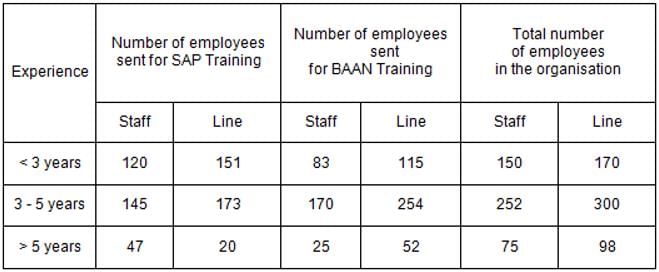
Total Number of employees = Staff employees + Line employees
Q. What percentage of the total number of employees in the organisation were sent for SAP training?
DIRECTIONS for questions: Answer the questions on the basis of the information given below.
Number of employees in an organisation who were sent for various training programmes-classified on the basis of their experience
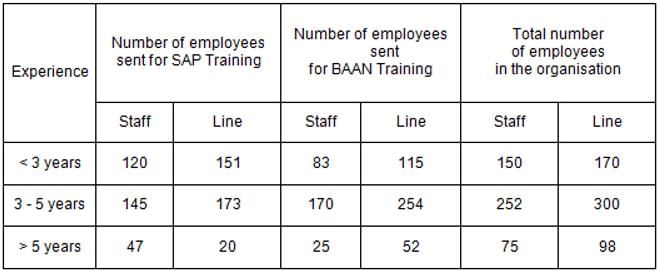
Total Number of employees = Staff employees + Line employees
Q. At least how many staff employees with an experience between 3 and 5 years underwent training in both the programmes?
DIRECTIONS for questions: Answer the questions on the basis of the information given below.
Number of employees in an organisation who were sent for various training programmes-classified on the basis of their experience
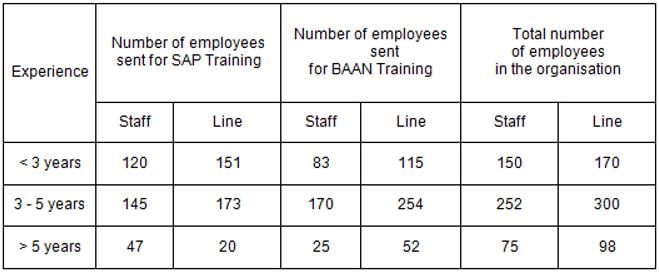
Total Number of employees = Staff employees + Line employees
Q. At most how many line employees with less than 3 years of experience underwent only BAAN training?
DIRECTIONS for questions: Answer the questions on the basis of the information given below.
Number of employees in an organisation who were sent for various training programmes-classified on the basis of their experience
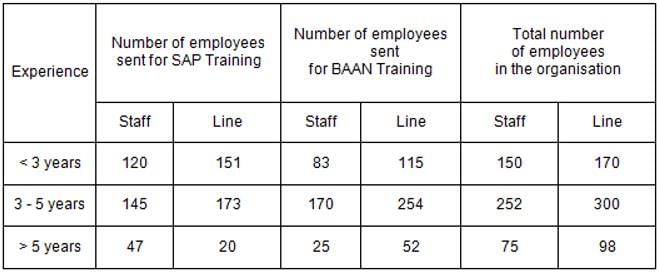
Total Number of employees = Staff employees + Line employees
Q. At most how many employees with an experience between 3 and 5 years underwent only SAP training?
DIRECTIONS for questions: Answer the questions on the basis of the information given below.
Three girls - Aishwarya, Ashmita and Ananya - and five boys - Raghuram, Ritvik, Rishi, Ramesh and Rana are sitting around a circular table such that no two girls are opposite or adjacent to each other. The following additional information is also known about the way they are seated:
i. Raghuram is four places away to the right of Rana.
ii. Aishwarya is to the immediate left of Ritvik.
iii. Ramesh and Ashmita are opposite each other.
iv. Rana is not adjacent to Ramesh.
v. Rishi is adjacent to two girls.
Q. Who is sitting opposite Ananya?
DIRECTIONS for questions: Answer the questions on the basis of the information given below.
Three girls - Aishwarya, Ashmita and Ananya - and five boys - Raghuram, Ritvik, Rishi, Ramesh and Rana are sitting around a circular table such that no two girls are opposite or adjacent to each other. The following additional information is also known about the way they are seated:
i. Raghuram is four places away to the right of Rana.
ii. Aishwarya is to the immediate left of Ritvik.
iii. Ramesh and Ashmita are opposite each other.
iv. Rana is not adjacent to Ramesh.
v. Rishi is adjacent to two girls.
Q. Who is sitting three places away to the right of Rana?
DIRECTIONS for questions: Answer the questions on the basis of the information given below.
Three girls - Aishwarya, Ashmita and Ananya - and five boys - Raghuram, Ritvik, Rishi, Ramesh and Rana are sitting around a circular table such that no two girls are opposite or adjacent to each other. The following additional information is also known about the way they are seated:
i. Raghuram is four places away to the right of Rana.
ii. Aishwarya is to the immediate left of Ritvik.
iii. Ramesh and Ashmita are opposite each other.
iv. Rana is not adjacent to Ramesh.
v. Rishi is adjacent to two girls.
Q. Who is to the immediate left of Rishi?
DIRECTIONS for questions: Answer the questions on the basis of the information given below.
Three girls - Aishwarya, Ashmita and Ananya - and five boys - Raghuram, Ritvik, Rishi, Ramesh and Rana are sitting around a circular table such that no two girls are opposite or adjacent to each other. The following additional information is also known about the way they are seated:
i. Raghuram is four places away to the right of Rana.
ii. Aishwarya is to the immediate left of Ritvik.
iii. Ramesh and Ashmita are opposite each other.
iv. Rana is not adjacent to Ramesh.
v. Rishi is adjacent to two girls.
Q. Who is sitting to the immediate right of Ritvik?
DIRECTIONS for questions: Answer the questions on the basis of the information given below.
The following table gives the details regarding the population and literacy rate in five districts - A, B, C, D and E. All questions pertain only to these five districts.

Q.In each of the following questions, two statements I and II are given. Assess whether each statement is true or false and mark your answer choice appropriately.
Statement I: In district B, the number of male illiterates is more than the number of female literates.
Statement II: The number of female literates in district A is 4.83 lakh.
DIRECTIONS for questions: Answer the questions on the basis of the information given below.
The following table gives the details regarding the population and literacy rate in five districts - A, B, C, D and E. All questions pertain only to these five districts.

Q. In each of the following questions, two statements I and II are given. Assess whether each statement is true or false and mark your answer choice appropriately.
Statement I: District E has the highest number of illiterate males.
Statement II: The number of illiterate males in district D is 3.32 lakh.
DIRECTIONS for questions: Answer the questions on the basis of the information given below.
The following table gives the details regarding the population and literacy rate in five districts - A, B, C, D and E. All questions pertain only to these five districts.

Q.In each of the following questions, two statements I and II are given. Assess whether each statement is true or false and mark your answer choice appropriately.
Statement I: The overall literacy rate of the five districts together is more than the overall literacy rate of district A.
Statement II: The female literacy rate is the highest in district D.
DIRECTIONS for questions: Answer the questions on the basis of the information given below.
The following table gives the details regarding the population and literacy rate in five districts - A, B, C, D and E. All questions pertain only to these five districts.

Q. In each of the following questions, two statements I and II are given. Assess whether each statement is true or false and mark your answer choice appropriately.
Statement I: The difference between the male and the female literacy rates is the highest in district D.
Statement II: More than 50% of the population of the five districts put together are males.
DIRECTIONS for questions: Answer the questions on the basis of the information given below.
A wholesaler dealer, Chinta Singh, deals with only six products - A, B, C, D, E and F. He purchases the products from the company at Rs.120, Rs.400, Rs.160, Rs.320, Rs.640 and Rs.140 per unit respectively and sells them to retail shopkeepers at Rs.184, Rs.460, Rs.256, Rs.352, Rs.720 and Rs.196 per unit respectively. He sells each product only in packs of 100 units.
Q. On a certain day, if he sold a total of 200 units, then which of the following cannot be his total profit on that day?
DIRECTIONS for questions: Answer the questions on the basis of the information given below.
A wholesaler dealer, Chinta Singh, deals with only six products - A, B, C, D, E and F. He purchases the products from the company at Rs.120, Rs.400, Rs.160, Rs.320, Rs.640 and Rs.140 per unit respectively and sells them to retail shopkeepers at Rs.184, Rs.460, Rs.256, Rs.352, Rs.720 and Rs.196 per unit respectively. He sells each product only in packs of 100 units.
Q. On a day on which he sold all the six products, selling 200 units of each product, what was his total profit?







